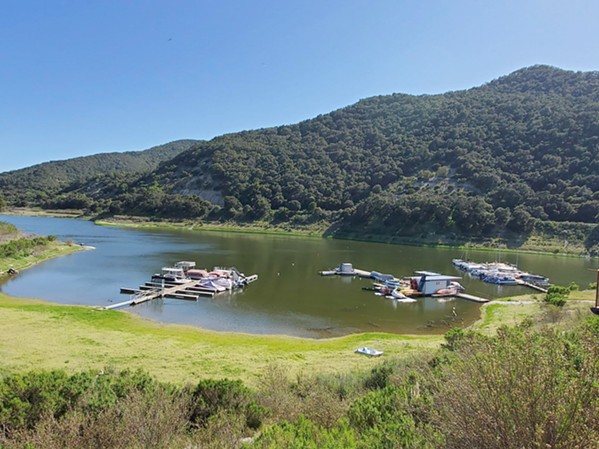[
{
"name": "Newsletter Promo",
"id": "NewsletterPromo",
"class": "inlineCenter",
"insertPoint": "4",
"component": "15264767",
"requiredCountToDisplay": "0"
},
{
"name": "Ad - Medium Rectangle CC01 - 300x250 - Inline Content",
"class": "inlineCenter",
"insertPoint": "8",
"component": "15582119",
"requiredCountToDisplay": "12"
},{
"name": "Ad - Medium Rectangle LC01 - 300x250 - Inline Content",
"class": "inlineCenter",
"insertPoint": "18",
"component": "15582122",
"requiredCountToDisplay": "22"
},{
"name": "Ad - Medium Rectangle 9 - 300x250 - Inline Content",
"class": "inlineCenter",
"insertPoint": "28",
"component": "15582121",
"requiredCountToDisplay": "32"
}]
Editor's note: This article was updated after Lake Lopez spilled on March 23.
After a quarter century, Lake Lopez Reservoir returned to an old habit.
Spilling every year since its inception from 1969 until 1987, followed by repeat incidents from 1996 to 1998, the dam overtopped again on March 23 at 4:21 a.m. due to the deluge of rain San Luis Obispo County has received since last December. County Public Works officials were on "spill watch" for roughly a week prior.
"The water will go to the Arroyo Grande Creek and out to the ocean," Public Works Engineer David Spiegel said. "We don't have the facilities to pipe it anywhere or have storage locations like they do in the Central Valley where it floods agricultural lands and let it percolate to the ground."
After two sets of heavy storms—one from December to January and another from March 10 to 14—the reservoir's capacity was at 88 percent, increasing to 98.8 percent after fresh rain March 21 and 22. The reservoir provides recreational and drinking water to residents in Arroyo Grande, Grover Beach, Pismo Beach, Avila Beach, and Oceano. Spiegel told New Times that water couldn't be released in advance from the dam to avoid spilling.
"Lopez Lake only has three valves that release water from the lake," Spiegel said. "If we did have to let the water out, it would take months and months. The pipes weren't sized to do flood releases."
The specific pipe Spiegel is referring to is a 42-inch diameter valve. The reservoir is also equipped with two 10-inch diameter jet valves that are turned on for "environmental releases," meaning water is sent downstream for the fish in the Arroyo Grande Creek and surrounding agricultural lands.
Unlike pipes of larger diameters attached to the Lake Nacimiento Reservoir and even dams in Oroville that can release 8,000-plus cubic feet per second (cfs) of water, Spiegel said that the valves on Lake Lopez's reservoir could maybe release 100 cfs.
"The piping was put in place when the dam was built," he said. "It would be one heck of a feat to add new valves."
Spiegel and Public Works are concerned about potential flooding in the creek levee if the dam overtops. On March 20, the county issued an evacuation warning for people living in the areas of the Oceano Lagoon and on the north and south sides of the levee. Previous New Times reporting found that county staff plugged gopher holes on the north side and installed a notch on the south side to prevent future flood damage.
"The notch is to help relieve some of the stress on the north side of the levee," Spiegel said. "We want the level to gradually decrease without it being a tidal wave of overflow."
Public Works staff is monitoring the reservoir round-the-clock. They've also posted road crews in areas where bridges go over the Arroyo Grande Creek, like Cecchetti Crossing and Huasna Road at Lopez Drive. Δ
Latest in News
Readers also liked…
-

When the levee breaks: Oceano residents, county officials walk a tightrope of regulations to manage Arroyo Grande Creek, which some say led to the levee's failure in January
May 18, 2023 -

Cal Poly report highlights offshore wind's potential to spur green energy transition
Jun 8, 2023 -

Cal Poly students demand rent control, accountability for substandard housing from SLO City Council
Jun 22, 2023









